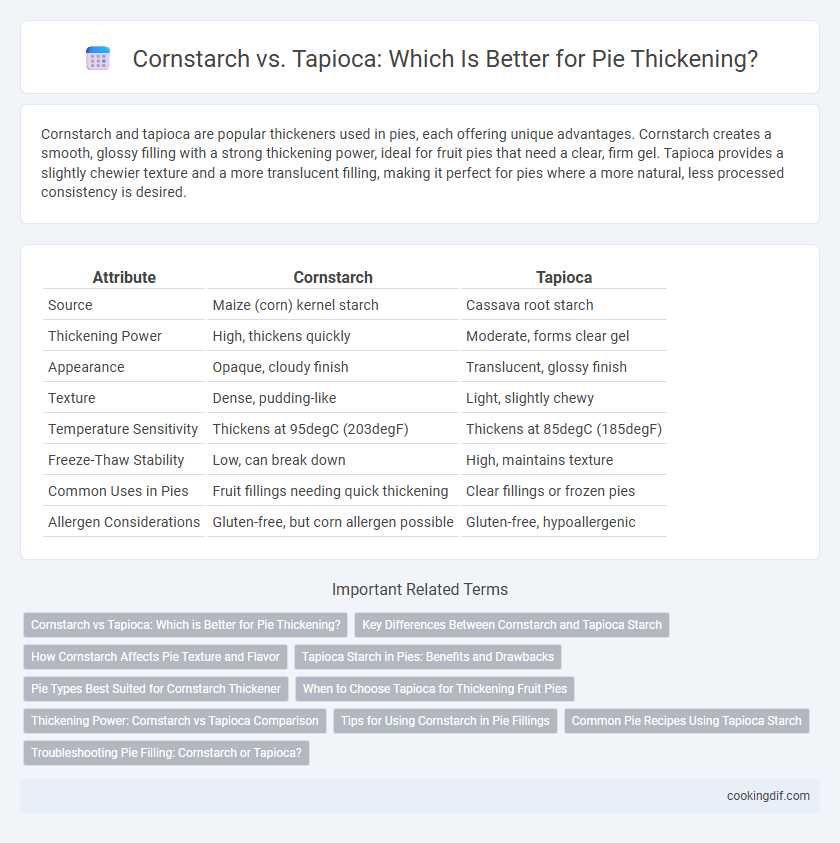Cornstarch and tapioca are popular thickeners used in pies, each offering unique advantages. Cornstarch creates a smooth, glossy filling with a strong thickening power, ideal for fruit pies that need a clear, firm gel. Tapioca provides a slightly chewier texture and a more translucent filling, making it perfect for pies where a more natural, less processed consistency is desired.
Table of Comparison
| Attribute | Cornstarch | Tapioca |
|---|---|---|
| Source | Maize (corn) kernel starch | Cassava root starch |
| Thickening Power | High, thickens quickly | Moderate, forms clear gel |
| Appearance | Opaque, cloudy finish | Translucent, glossy finish |
| Texture | Dense, pudding-like | Light, slightly chewy |
| Temperature Sensitivity | Thickens at 95degC (203degF) | Thickens at 85degC (185degF) |
| Freeze-Thaw Stability | Low, can break down | High, maintains texture |
| Common Uses in Pies | Fruit fillings needing quick thickening | Clear fillings or frozen pies |
| Allergen Considerations | Gluten-free, but corn allergen possible | Gluten-free, hypoallergenic |
Cornstarch vs Tapioca: Which is Better for Pie Thickening?
Cornstarch provides a smooth, glossy finish and thickens pies quickly at lower temperatures, making it ideal for fruit pies with a custard-like texture. Tapioca offers a more translucent, chewy consistency and stays stable during freezing and reheating, which benefits pies needing a gel-like, stretchy filling. For reliable thickening with a classic pie texture, cornstarch is often preferred, while tapioca excels in showcasing natural fruit shapes and providing texture durability.
Key Differences Between Cornstarch and Tapioca Starch
Cornstarch and tapioca starch differ significantly in their thickening properties, with cornstarch providing a translucent, glossy finish ideal for clear pie fillings, while tapioca starch offers a more stable thickening with a chewy texture, perfect for fruit pies. Cornstarch thickens quickly at lower temperatures but can break down when overheated, whereas tapioca starch remains thick and smooth even after prolonged cooking or freezing. Nutritionally, cornstarch is primarily amylose-rich, contributing to its firm gel, whereas tapioca starch contains more amylopectin, enhancing elasticity and freeze-thaw stability in pie fillings.
How Cornstarch Affects Pie Texture and Flavor
Cornstarch thickens pie fillings by creating a glossy, smooth texture with a slightly translucent appearance, enhancing the pie's visual appeal. It forms a gel-like consistency that is firm yet tender, preventing the filling from becoming too runny or overly stiff. Cornstarch imparts a neutral flavor, allowing the natural taste of the pie ingredients to remain prominent without adding any starchy aftertaste.
Tapioca Starch in Pies: Benefits and Drawbacks
Tapioca starch offers a clear, glossy finish and excellent freeze-thaw stability, making it ideal for fruit pies that require reheating without becoming watery. Its neutral flavor allows the fruit's natural taste to shine, and it creates a slightly stretchy, elastic texture that enhances mouthfeel. However, tapioca starch can break down faster than cornstarch when exposed to prolonged heat, potentially resulting in a less firm filling if overcooked.
Pie Types Best Suited for Cornstarch Thickener
Cornstarch works best for fruit pies with high acidity, such as cherry or berry pies, because it thickens quickly and creates a glossy, smooth filling. It excels in custard-based pies like lemon or chocolate cream, providing a clear, firm set without cloudiness. For pies requiring a short bake time and a clean flavor, cornstarch is preferable to tapioca, which may produce a chewier texture and less transparent glaze.
When to Choose Tapioca for Thickening Fruit Pies
Tapioca is ideal for thickening fruit pies with high acidity or very juicy fillings, such as cherry, blueberry, or raspberry, due to its superior clarity and ability to maintain a glossy finish. It provides a smoother texture and less tendency to break down during baking compared to cornstarch, making it perfect for pies baked longer or stored overnight. Tapioca also resists thinning when reheated, ensuring a consistently thick and appealing filling.
Thickening Power: Cornstarch vs Tapioca Comparison
Cornstarch typically offers stronger thickening power than tapioca, often requiring less quantity to achieve a firm pie filling. Tapioca provides a clearer, glossier finish and retains its thickening ability even after freezing, making it ideal for fruit pies. The choice between cornstarch and tapioca depends on desired texture, clarity, and consistency in the pie filling.
Tips for Using Cornstarch in Pie Fillings
Cornstarch creates a clear, glossy finish and provides a smooth texture when thickening pie fillings, but it requires careful heat control to avoid breaking down and thinning out. Use cornstarch by mixing it with cold water before adding to hot pie filling, and cook just until thickened to maintain its effectiveness. Avoid overcooking or reheating cornstarch-thickened pies to prevent the filling from becoming watery.
Common Pie Recipes Using Tapioca Starch
Tapioca starch is preferred in common pie recipes like fruit pies and custard pies for its clear, glossy finish and smooth texture that enhances the filling without altering flavor. Compared to cornstarch, tapioca provides superior freeze-thaw stability, making it ideal for pies that need to be refrigerated or frozen, such as mixed berry pies and tropical fruit pies. Its fine granules create a stable, elastic gel that thickens fillings quickly and maintains consistency during baking, improving the overall pie quality.
Troubleshooting Pie Filling: Cornstarch or Tapioca?
Cornstarch provides a smooth, glossy finish and thickens quickly, but can break down and become runny if overcooked or exposed to too much acidic filling. Tapioca, especially instant or minute tapioca, offers a more stable, gel-like texture that withstands long baking times and acidic ingredients without thinning. For troubleshooting pie filling that is too runny or lacks firmness, tapioca is often preferred for fruit pies, while cornstarch works well for cream or custard pies requiring a silky texture.
Cornstarch vs tapioca for pie thickening Infographic

 cookingdif.com
cookingdif.com